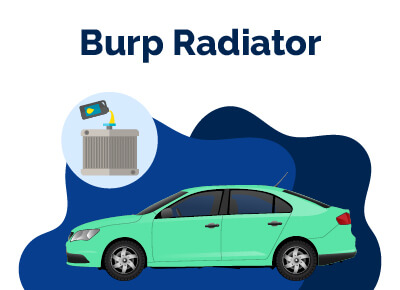Burp the Radiator (Everything You Need To Know)
July 22, 2023


Chris is Head of Content for FindTheBestCarPrice and is based out of Philadelphia, PA. As a seasoned automotive industry analyst and car enthusiast, he ensures the highest level of quality across all our content and curates our picks for the best deals each month.
Chris studied information systems and marketing at Drexel University and writes about a wide range of topics ranging from car buying tips to troubleshooting common mechanical issues.
When he’s not thinking about cars, he likes to stay in with his dog and make an “attempt” to finish a crossword puzzle (he’s not quite at the Saturday/Sunday level…yet). As a former cheesemonger, Chris still has a “sharp” passion for all things cheese, and his fridge is always loaded with it!
Chris also has a passion for things that go fast, and drones are no exception. He spends some of his time writing for Dronesourced.
Burp radiator is a term used to describe a simple yet effective technique for removing air pockets or "airlocks" from a car's cooling system.
Airlocks can cause overheating and other severe problems in the engine, and traditional methods of bleeding the cooling system can be time-consuming and often ineffective.
On the other hand, the burp radiator technique involves a straightforward process of filling the cooling system with coolant, then running the engine with the radiator cap off to allow any trapped air to escape.
The burp radiator technique is particularly advantageous for automobiles equipped with intricate or inaccessible cooling systems and can be executed expeditiously and effortlessly with minimal resources or specialized knowledge.
Moreover, burping the car radiator can help to prevent engine damage and prolong the life of your vehicle, making it a worthwhile maintenance practice for any car owner.
So if you're experiencing overheating or other issues with your car's cooling system, consider burping the car radiator to keep your engine running smoothly and reliably.
Table of Contents
How To Burp Your Radiator
To successfully burp your radiator, take the following simple steps:
1. Identify the Symptoms
To ensure your vehicle's cooling system operates at peak efficiency, you must recognize indications that your car's radiator may malfunction.
The process of bleeding the radiator is akin to that of a home's radiator and removes pockets of air trapped in the system.
Failure to do so can inhibit antifreeze circulation, leading to overheating the car's engine. Look out for any of the following tell-tale symptoms that could indicate that your car's radiator requires bleeding:
The dashboard temperature meter indicates a significantly high-temperature reading.
2. Boiling of Fluid From the Radiator
Unusual smells from the engine, delightful smells, result from antifreeze leakage or combustion.
The low coolant light turns on immediately after starting the vehicle.
B bleed the radiator after performing any maintenance or replacing parts of your cooling system is also advisable.
Air may enter the system during maintenance procedures; therefore, keep an eye on the temperature gauge after making any modifications.
3. Perform Bleeding of the Radiator
Locate and loosen the car's bleed valve. Most cars have bleeder valves incorporated into the cooling system to release the trapped air.
Check your owner's manual to locate the exact position of the valve, typically at the highest point of the cooling system, where air naturally rises to release the air effectively.
To bleed the car's radiator via the bleeder valve, loosen the valve until the sound of hissing air can be heard. Ensure you use a cloth to catch any coolant spattering, and then retighten the valve when a steady stream of coolant starts to flow.
Some cars may not have bleeder valves. However, it is still possible to bleed these cars' radiators through other methods.
4. Make Sure the Car Is Not Hot When Performing the Process
Start the car with the radiator cap off. Remove the radiator cap if your car does not have a special bleeder valve.
In contrast, the car idling for about fifteen to twenty minutes can help release the air pockets from the cooling system and bubble out of the car's radiator.
Elevate your car. Raising the front of your car can speed up the release of air from the system since air naturally rises.
Use a jack to raise your car and ensure the radiator cap is loosened or removed before lifting the vehicle.
Perform a "flush and fill." After bleeding the radiator, replacing the old coolant with fresh coolant is advisable to ensure maximum cooling system performance.
Drain old coolant and add fresh coolant according to your owner's manual's instructions. Be careful not to overfill the coolant during this process.
What Happens If You Don't Burp Your Radiator?
Over a while, air may get confined in the radiators, resulting in patches of cold areas and suboptimal functioning of your household heating appliances.
If you refrain from venting your radiators, the problem will exacerbate with time. This could eventually culminate in your central heating system being incapable of attaining your desired temperature, even when cranked up to the maximum.
Other Symptoms of Radiator Airlock
A mere trace amount of air can form pockets that impede the smooth flow of coolant. Indicators and indications of an airlocked radiator encompass the following:
- Overheating during typical driving conditions
- Inadequate heater performance
- Decreased operational efficiency
- Rapid loss of coolant and radiator leakage
- Persistently overheating your engine is detrimental, and failing to address this issue can result in significant and expensive repairs in the future.
What Causes Radiator Airlock?
The primary catalyst for radiator airlock often results from insufficient pressure maintenance, typically involving the radiator cap. Its role is not only to prevent coolant leakage but also to maintain system pressure.
Failure of the cap at high temperatures can lead to the formation of air pockets within the system, and air may also enter the system, further increasing the likelihood of an airlock.
Fortunately, removing air pockets is relatively simple; however, identifying the root cause of the airlock is crucial.
Additional causes may include a leaky radiator hose, which can enable air to infiltrate the system, particularly when the hose has multiple splits or has gone unattended for an extended period.
Improper flushing of the system can leave pockets of air trapped inside, and an inadequate coolant refill can allow bubbles to form.
A blown head gasket can force air into the cooling system from the combustion cylinder, causing bubbles to form. Now that you understand the concept of a radiator airlock and recognize the symptoms, prompt action is necessary.
How the Cooling System Works
The fundamental objective of a vehicle's cooling system is to maintain an optimal operating temperature to prevent potential heat-induced damage to the engine. The cooling system regulates any temperature surpassing the ideal range.
Regulated by the thermostat, the cooling system operates in response to temperature fluctuations.
Upon sensing the need for cooling, the thermostat opens to allow the liquid coolant to flow through the engine block to absorb the heat generated during combustion. The heated coolant then travels to the radiator to be cooled.
The coolant passes through the radiator tubes while external airflow moves over the fins to extract heat and reduce the temperature of the coolant. After being cooled, the coolant returns to the engine block, completing the cycle.
Best Car Deals by Category
Frequently Asked Questions
What is burping a radiator in a car?
Burping a radiator releases trapped air from the cooling system of a car's radiator. It is also known as "bleeding" the radiator. Trapped air in the cooling system can cause reduced performance or overheating.
When should I burp my car's radiator?
You should burp your car's radiator if you notice any symptoms of trapped air, such as a gurgling sound, fluctuating temperature gauge, or cold spots in the radiator.
It's also recommended to burp the radiator after any maintenance work that may have introduced air into the system.
How do I burp my car's radiator?
To burp your car's radiator, you must locate the radiator cap and slowly open it while the engine is excellent. Start the engine and let it run until it reaches the average operating temperature, then turn it off and allow it to cool.
Check the coolant level and add more if necessary. Repeat this process until no more air bubbles escape when opening the radiator cap.
Can I burp my car's radiator, or do I need a mechanic?
The burp radiator technique is a relatively simple process that can be done by most car owners themselves. However, if you are uncomfortable working on your car's engine, it's best to take it to a mechanic.
What happens if I don't burp my car's radiator?
If you don't burp your car's radiator, trapped air can cause reduced performance, overheating, and potential damage to the engine.
Overheating can lead to warping or cracking of the engine block, which can be expensive to repair.
How often should I burp my car's radiator?
It's recommended to burp your car's radiator at least once a year to ensure no trapped air in the cooling system.
You should also burp the radiator if you notice any symptoms of trapped air or after any maintenance work that may have introduced air into the system.
Posted in Car Buying Tips, Car Troubleshooting |




